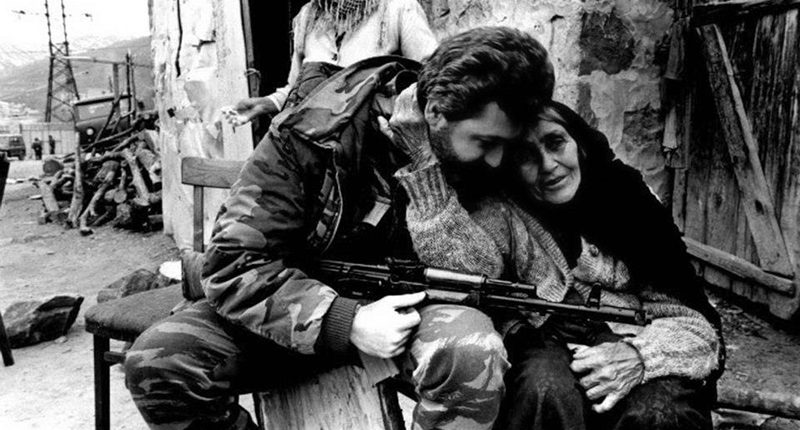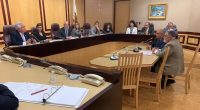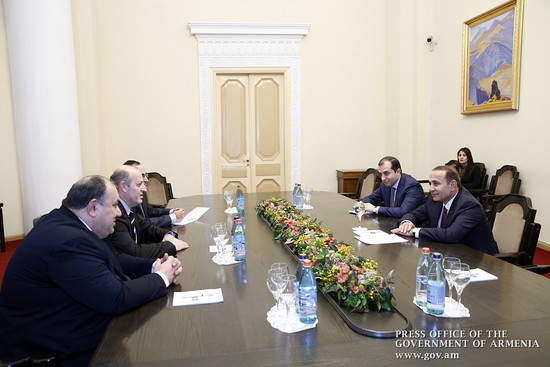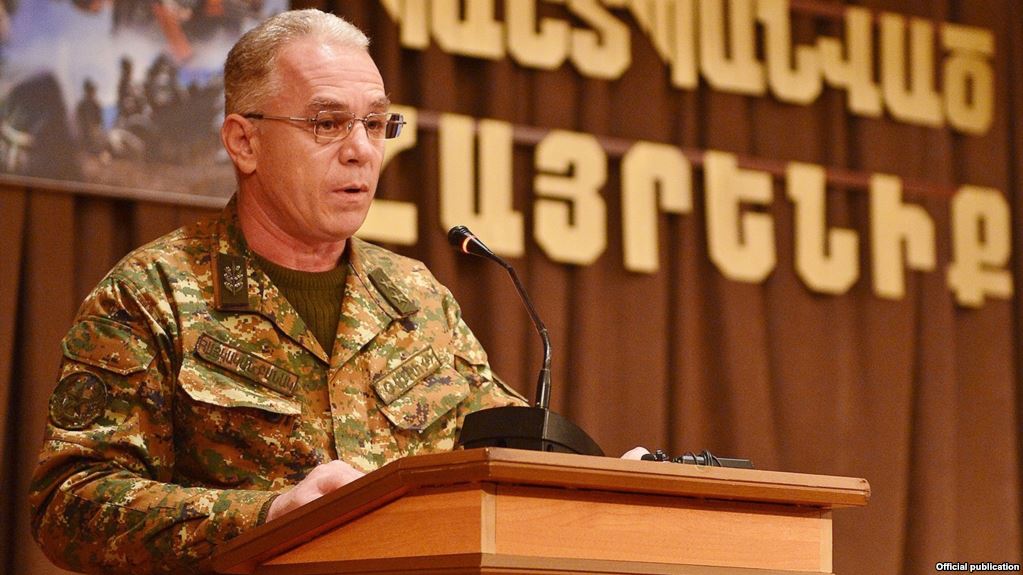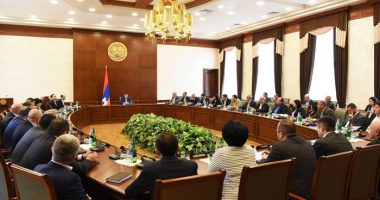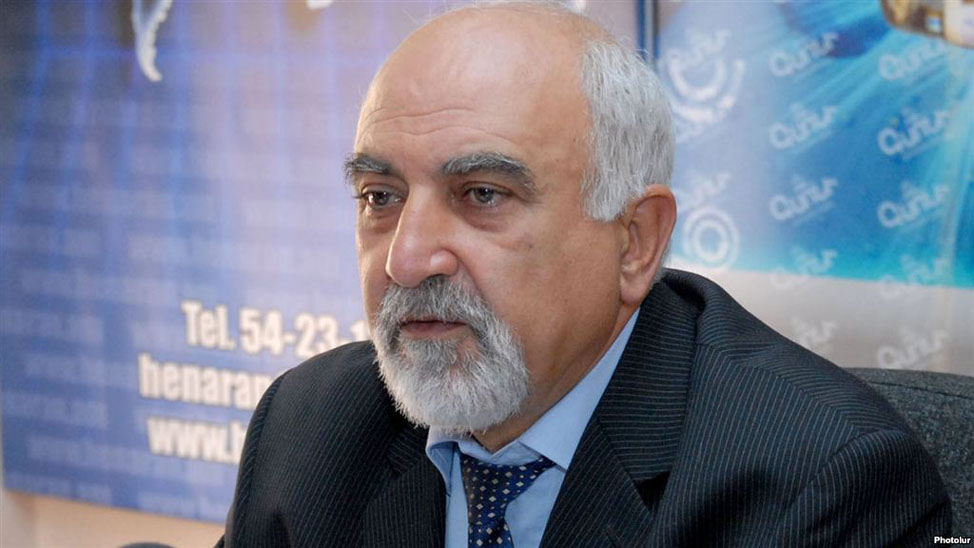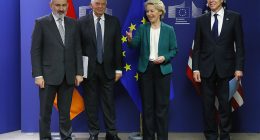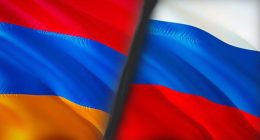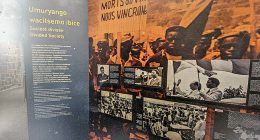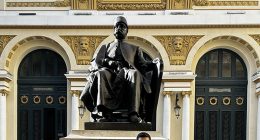By Susanna Harutyunyan
On March 1st an article was published on “Radio Van” website, which revealed another campaign venture of Baku using a documentary photograph of the illustrious Armenian photographer, Zaven Khachikyan.
Author Marina Galoyan writes, citing Azeri Haqqin.az website, “Young Azerbaijani artists and sculptors demonstrated their works in Q Gallery Berlin on the occasion of the 27th anniversary of the events in Khojali.” The author also notes that “as can be seen from the photographs from the exhibition, among the presented works there was also a picture of a student of the Academy of Arts of Azerbaijan Roya Gasanova, replicating a famous photograph of Hatspanian and an Azeri grandmother. The picture of the student was called “Hope”. (https://radiovan.fm/station/article/8016) This line by itself, does not make it inaccurate – could the artist be saying given the impression from the photograph, the fact that the Armenian soldier and the Azeri grandmother inspire hope? or was the caption inaccurate? how? If the person painted the image is it still liable for copyright?
This is not the first attempt of Azerbaijani-Turkish propaganda to falsify history (in particular the events of 1992-1993 – the period of active military conflict in Nagorno-Karabakh), using “photo documents” and, in particular, this photo by Zaven Khachikyan. More than 20 years ago, the Turkish newspaper Milliyet published the same photo in its own interpretation, “an Azerbaijani woman kisses her grandson and sends him to the front to avenge the Armenians.” (This quote clearly falsifies the caption v. the one called hope, a qualifies the propaganda)
Same as at the Berlin exhibition in 2019, Sarkis Hatspanian, a hero of the Karabakh war, later a political figure and an expert on regional issues, was represented here as an Azerbaijani soldier (how do you know this from the article if the artist only called it ‘hope’). Perhaps, at the time of the absence of the Internet the “lie/falsification” would work, if not the publication in the French “Libération” almost the same time, where the true history of the photograph was presented, indicating the author and the main “characters”. Then, after the publication of Milliyet, a friend of Sarkis Hatspanian, who lived in Paris, sent both newspapers to the Council of Europe – as a vivid example of the lies spread by Turkish propaganda.
In order to find out the true story of the photograph (which, has nothing to do with the events of 1992 in Khojali), we met with one of the most known Armenian photographers Zaven Khachikyan. Zaven Khachikyan’s camera once captured many episodes of the Karabakh war, creating photographic works that became an iconic symbol of that time. Many of these works have found a place in the latest photo book by Zaven Khachikyan “black white tricolor”, dedicated to the 25th anniversary of the independence of Armenia. The book was awarded the RA Presidential Award in May of 2018. A special chapter in the book is the Karabakh war. However, there are no photos of the ‘Armenian soldier and Azerbaijani granny’ in this book. Zaven Khachikyan assured that the photo will be included in the second, revised edition of the book, on which he is currently working; he also told the story behind this photoshoot.
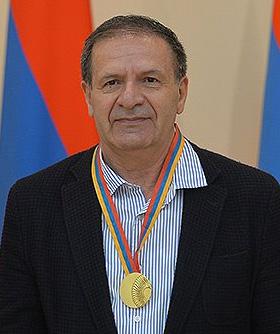

– In April 1993, together I was with my friend, photographer Ruben Mangasaryan, we were accompanying the Armenian Army in the battles for the Karvachar region (Azerbaijanis call this region, Kelbajar). In the emancipated Karvachar Azerbaijani civilians, mostly old men, women, and children were remaining. Men escaped, Azerbaijani army abandoned them to the mercy of fate.
I was always interested as a photographer and as a person and focused on these particular moments of pause, silence, despite after intensive fights. The civilians, who, according to the laws of war, found themselves in the status of captives, were frightened and confused; they didn’t know what would happen to them or what they would do to them. They were told that they would be sent across the front line to Ganja (former Kirovabad). However, at that time no one was sure…
But even in such force majeure situations, despite any circumstances, a person remains a person and tries to adjust his usual life and the rhythm of life. Women baked bread and cooked food – both for their own and for us, Armenians, soldiers; the old people, overcoming the subconscious fear, were not against to make contact – of course, those who understood Russian. I will not forget my conversation with the local physics teacher. When he found out that I am also a physicist by my education, not only spoke about himself but even tried to convince me of his version of the causes of the Nagorno Karabakh conflict which seemed absurd, in that particular situation! But I was really interested as a human to listen, to ask, to watch, to photograph; these people were not enemies for me. I tried to capture their faces, characters, situations.
Among the locals, there was an elderly woman who stood out among the others and was treated with special respect. I immediately noticed her. She tried to tell me something in Azerbaijani. I started looking for someone who could understand and translate. Not far away was Sarkis Hatspanian, who was responsible for the captives and with whom we met probably three days before. Sarkis was born in Turkey and knew Turkish, so he communicated easily with locals. I asked him to translate that elder woman and ask what she wants to tell me. Sarkis sat down with her, and they started an emotional and, I dare say, warm conversation. I tried to step in asking Sarkis what she was talking about, but Sarkis said to me: “Wait, I will explain later, Sheikha-Khanum tells interesting things.” Sheikha-Khanum – that was her name.
I started photographing. At some point, Sheikha Khanum raised her hands as if embracing Sarkis. I did not miss the moment – one, two, three, four … There are several variations of the same photo, a kind of photo sequence. In a certain sense, I initiated or staged the whole situation, but my “director’s intention” lay on fertile ground, since it was impossible to artificially line up a conversation between the Armenian soldier and the Azerbaijani khanum in front of the camera and moreover. It was absolutely impossible “to direct” emotion. It was how this photo was born – the photo which became a symbol of Armenian attitude to the Karabakh conflict, and for Baku – the subject of speculation and falsification.
What exactly Sarkis spoke about with Sheikh Khanum and how the further fate of the woman was formed – Sarkis himself best of all spoke about this in one of his recent interviews.
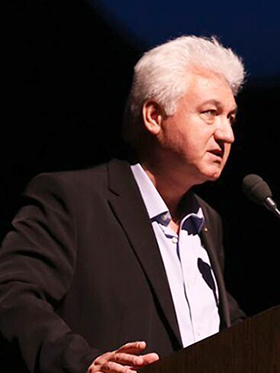

– Sheikha-Khanum … was distinguished by her sharp mind, eloquence was a downright innate philosopher. I loved talking to her. “This is not a war of our nations,” she said, “we love Armenians, we know that this is their country, everywhere there are Armenian graves, khachqar’s, signs of their culture”.
She said that the Armenians were more humane than Azeris, that her sons escaped, leaving helpless mother, “and these guys here” very carefully treated both her and other Azerbaijanis. “I would like to have such sons,” said Sheikha-Khanum, pointing to us, and for the first time admitted that her son, the Chief of police of Karvachar, escaped, leaving his mother. It was during this conversation that Zaven Khachikyan took a picture of us imperceptibly.
We lived together for almost 20 days. Before sending them to Kirovabad (Ganja), we asked them to return to their homes and take away the hidden valuables things, assuring that we would not take anything away. By the will of fate, we, Armenians, were often forced to leave our wealth and our homes, this pain is in our blood, therefore we will never become like the Turks. The situation reached the point of absurdity: saying goodbye to us, the Azerbaijanis cried, hugged us … Ensured in their safety, we sent them to Kirovabad… And at that time Baku was blowing the whole world that there was a terrible thing in Karvachar, that Armenians kill civilians.
After, we found out that later, when foreign journalists arrived in Kirovabad and asked how the Armenians treated them in captivity, Sheikha-Khanum, despite all the threats and warnings, told the truth. She said that Armenians in Karvachar treated them better than Azerbaijanis in Kirovabad.
Both the photograph itself and the story behind its creation are indisputable evidence of historical truth, which is, in fact, stronger than any falsification. The human message that Zaven Khachikyan managed to accumulate in the photographic document, in the image of the Armenian soldier, received a great international response. The photo has been published in many foreign newspapers, presented in exhibitions, and the Swiss Red Cross (Armenian office) with the permission of the author replicated it and used it for several years in their collateral. During this period, many who were arriving at Yerevan airport Zvartnots could see a huge poster of the Swiss Red Cross with a photo of an Armenian soldier and an Azerbaijani grandmother.
And most recently, in November-December 2018, Zaven Khachikyan included the photo in his personal exhibition in Toronto. The exhibition was organized by the “Barev” Cultural Center and was timed to the 90th anniversary of the establishment of Holy Trinity Armenian Apostolic Church in Toronto. At the gala charity event dedicated to this event, the author presented the true story of the photograph and donated it to Holy Trinity Armenian Apostolic Church.

